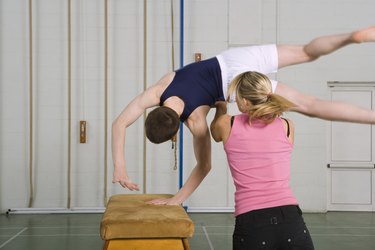
Gymnasts are known for their ability to perform many tricks and stunts on beams, in the air and on the ground. In order to execute such tricks, gymnasts need to be in top physical shape.
Successful gymnasts go through intense training to fulfill the top five components in gymnastics such as muscle strength, cardiovascular endurance and flexibility to ensure their safety and an optimal performance. Without these fitness components, gymnasts will most likely struggle while executing routine gymnastic moves.
Video of the Day
Video of the Day
Enhanced Flexibility
It's no secret that flexibility is essential to a gymnast's ability to perform certain stunts such as splits and backbends. Flexibility refers to the ability to move or bend joints in a wide range of motion with ease and without injury. (Gymnastics statistics show there are more than 86,000 gymnastics-related injuries in the U.S. each year, according to STOP Sports Injuries.)
It may also be an asset to improving coordination and balance. Because flexibility is such an important part of the sport, many gymnasts are often tested to determine the level of their flexibility. According to USA Gymnastics, flexibility is determined via the ability to perform forward kicks, side kicks, leaps and splits. Should gymnasts not rank highly on their flexibility tests it is suggest they try to enhance flexibility by stretching frequently. Once common stretch is holding the leg straight up for about 30 seconds. In the event a gymnast doesn't have a high range of flexibility she is at risk for injuries such as pulled muscles.
High Strength Levels
Strength is the ability of a muscular unit or combination of muscular units to apply force, according to Crossfit Journal. Adequate strength levels are a fitness component that forms the foundation for learning new skills in gymnastics. Without building up high levels of strength, gymnasts would be unable to execute correct technique when demonstrating skills such as handstands. If a gymnast didn't have enough strength, she would have difficulty performing new skills and would need to spend significant amounts of time relearning them. As a result, gymnasts commit to consistent special training to increase muscle size to build up strength so they can lift their own body weight when practicing tumbles and be able to use proper technique. Regimens consisting of pushups, rope climbs and pulls up are often practiced to increase strength.
Adequate Agility
Agility refers to the ability to transition between several positions efficiently and quickly -- important for completing floor routines and exercises on the balance beam, such as back flips and somersaults. A timed test is often administered to gymnasts to determine their agility level. During these tests, gymnasts are usually asked to run diagonally across a room within a certain time frame. Failure to meet certain time requirements means a gymnast needs to work on improving, says a 2012 study published by the "International Journal of Sports Physical Therapy." Gymnasts can develop agility by practicing sprints in the shape of a figure eight or jumping from side to side very quickly.
Maximum Endurance
Endurance, or a muscle's ability to continuously perform without growing tired, is a fitness component that is challenged routinely during training. Gymnasts rely on endurance so they can repeat various movements repeatedly without losing momentum. Their ability to run through routines or training regimens during practice consistently may directly correlate with their ability to perform. Because a lack of power or endurance may hinder the execution of stunts, gymnasts may spend a great deal of time honing strength endurance by doing situps or other similar training exercises.
Ideal Body Composition
A precise body mass measurement of fat and muscle is a fitness component that is crucial to gymnasts. Too much body fat would make it difficult for gymnasts to move freely while having too much muscle would increase weight greatly and hinder the gymnasts ability to carry out various exercises correctly. As a result, gymnasts are weighed and measured frequently to monitor their composition. In order to perform at high levels, gymnasts strive to have compatible muscle, fat and bone ratio. This means that gymnasts work hard to make sure they do not have too much body fat in correlation to their weight. By following detailed nutrition plans and workout regimens, a gymnast will be able to control her weight while making sure she is fit enough to limit the amount of unwanted fat.